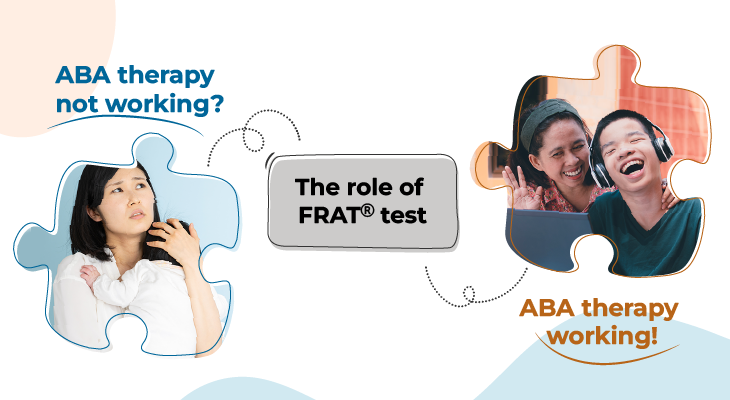Imagine this: Your child is playing happily at the park. Suddenly, the ice cream truck’s music pierces the air. Your child stops playing, her brow furrows, and she begins to fidget. She might whimper or repeat sounds she often makes when feeling overwhelmed. You try offering a snack, but she pushes it away, her frustration mounting. This is the beginning of a meltdown, and while it can appear confusing, it’s important to remember that it’s a way for your child to communicate their distress.
This blog will dive deeper into understanding autism meltdowns, exploring triggers, differences from tantrums, prevention strategies, and supportive tips.
Table of Contents
- What is an autism meltdown?
- Autistic Meltdown vs. Tantrum – Understanding the Overflow
- What triggers autism meltdowns?
- How long can autistic meltdowns last?
- How do autistic meltdowns end?
- What age do autistic meltdowns start?
- Preventing autism meltdowns
- DON’Ts in autism meltdowns
- Helping Hand: Tips for Responding to a Child’s Meltdown in Public
- Conclusion
- Did You Know About Folate Receptor Autoantibodies (FRAAs) and Brain Development?
- References
What is an autism meltdown?
An autistic meltdown is an intense response to feeling overwhelmed. It happens when someone on the autism spectrum experiences too much sensory input, a sudden change in routine, or extreme emotions, and they can no longer cope.
Autistic meltdowns are a sign that someone needs help. They are a genuine expression of distress caused by an inability to cope with the situation.
The term “meltdown” appears to have originated in the 1970s and gained widespread use in the following decades. Though the exact reason for choosing this term is unclear, it’s speculated that the word evokes the image of an uncontrolled and potentially destructive event, similar to a nuclear meltdown.
Everyone on the autism spectrum experiences meltdowns differently. Reactions may be:
- Physical: For ex. Kicking, hitting objects, throwing things, stimming,
- Emotional: For ex. Crying, facial expressions of distress, avoiding eye contact, withdrawal (shutdowns), hiding, or clinging to a parent or trusted adult
- Verbal: For ex. Shouting, yelling, screaming
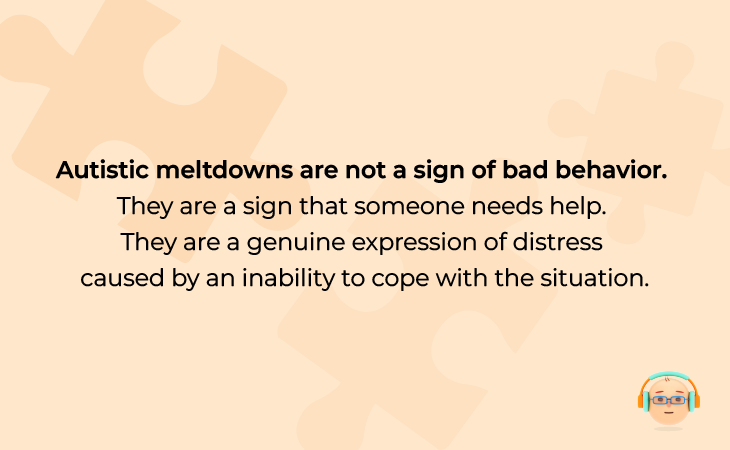
Download Download & share this knowledge card in your network [Free Download]
Autistic Meltdown vs. Tantrum - Understanding the Overflow
It’s important to understand that meltdowns are not tantrums. Let’s understand this with an analogy.
Imagine each of your child’s emotions as a separate bucket. Throughout the day, various experiences fill these buckets: the frustration of a difficult task, the joy of playing with friends, the anxiety of a new environment.
- Tantrums: A tantrum is like one specific bucket overflowing. Maybe the bucket labeled “frustration” fills up because they can’t build a tower with blocks. Once you help them solve the problem (show them a different building technique), the bucket empties, and they calm down.
- Meltdowns: A meltdown is different. It’s like multiple buckets overflowing at once. The “noise” bucket might be full from the sounds of a crowded restaurant. The “light” bucket could be overflowing from bright overhead lights. And the “change” bucket might be full because they didn’t get their usual bedtime routine. Suddenly, everything is too much – all the buckets are spilling over. This sensory overload can lead to crying, yelling, or withdrawal – their way of trying to signal that they need help.
Here’s a breakdown of the key differences:
| Autistic Meltdown | Tantrum | |
| Cause | Sensory overload, difficulty coping with changes, feeling overwhelmed. | A specific desire not being met for ex. Inability to build a tower with blocks. |
| Goal | A loss of control due to overwhelming feelings and inability to cope. | Often used to exert control and get what they want. |
| Reaction | Requires reducing the overwhelming factors (calming environment, familiar routine). | Calms down once the desire is fulfilled. For ex. Tower built with a different building technique. |
| Remember | Meltdowns are a sign that your child needs help managing their sensory input and emotions. | Tantrums are a normal part of childhood development. |
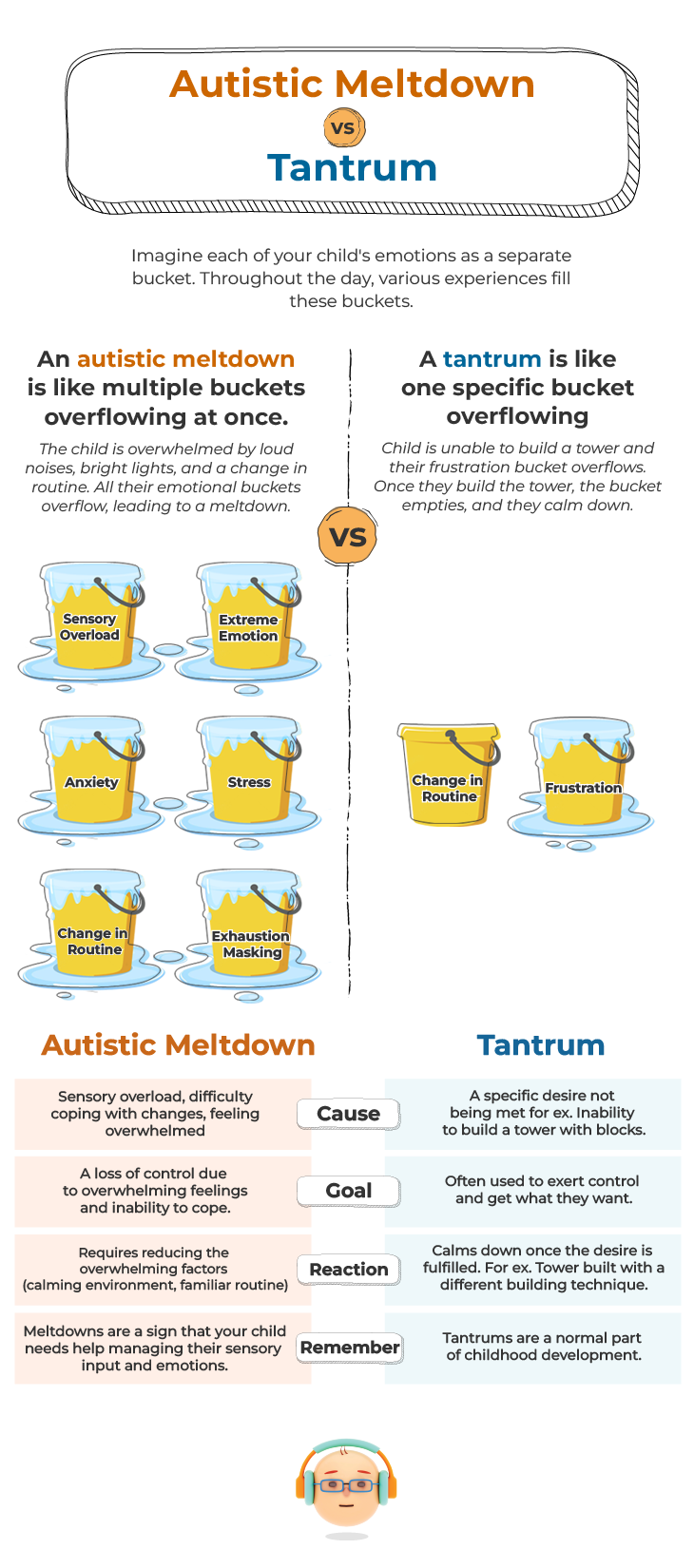
Download Download & share this infograph card in your network [Free Download]
What triggers autism meltdowns?
Everyone on the autism spectrum is unique and can vary depending on the individual’s age, developmental level, and personal sensitivities. By understanding the common triggers, you can help identify potential challenges. Here’s a list of common triggers for autistic meltdowns:
- Sensory overload
- Loud noises: Traffic, sirens, crowded environments, loud music, etc.
- Bright lights: Fluorescent lights, flashing lights, sunlight, etc.
- Strong smells: Perfumes, cleaning products, strong food smells, etc.
- Uncomfortable textures: Scratchy clothing, tags on clothes, certain fabrics, etc.
- Taste and smell sensitivities: Dislike for certain foods or textures.
- Touch sensitivities: Dislike of being touched, hugged, or having their hair touched.
- Change in routine and environment
- Unexpected changes: Cancellations, changes in plans, detours, etc.
- Unfamiliar environments: New places, crowded spaces, busy streets, etc.
- Transitions: Moving from one activity to another, getting ready for bed, etc.
- Social and emotional challenges
- Frustration: Difficulty completing tasks, communication difficulties, feeling misunderstood, unable to express needs, unmet needs.
- Frustration with social interaction: Difficulty understanding social cues, feeling overwhelmed in social situations.
- Exhaustion from masking
- Anxiety: New situations, social anxiety, fear of the unknown.
- Over-stimulation from social interaction: Spending extended time in social settings, needing personal space.
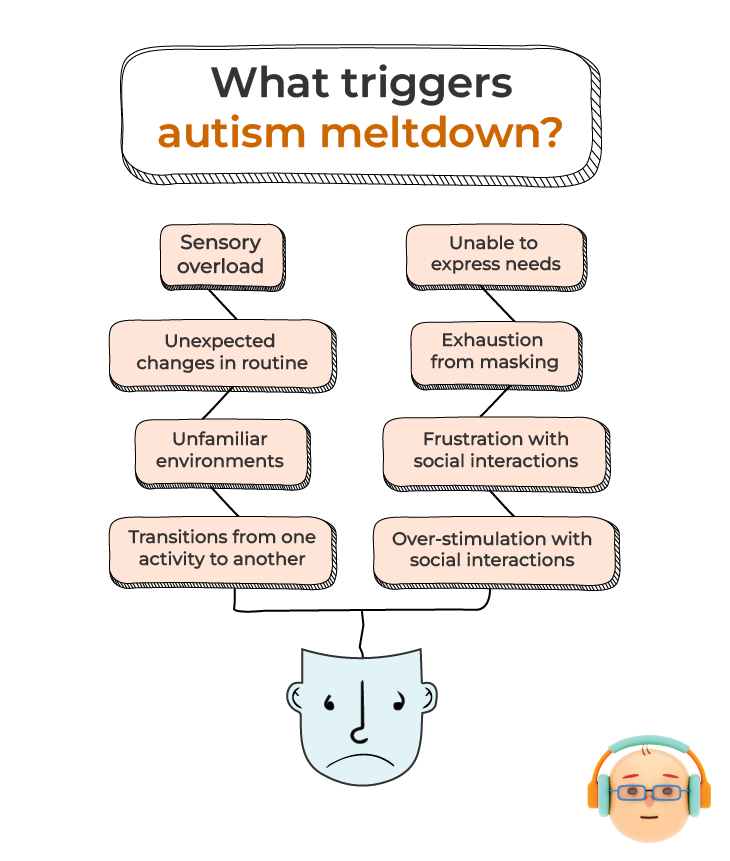
Download Download & share this infograph card in your network [Free Download]
How long can autistic meltdowns last?
The duration of an autism meltdown can vary significantly and depends on several factors, including:
- The severity of the triggering event: A more intense trigger might lead to a longer meltdown.
- The individual’s coping mechanisms: Individuals who have developed effective coping strategies might be able to regulate their emotions and calm down sooner.
- The support provided during the meltdown: Providing a calm and supportive environment can help the individual feel safe and facilitate the calming process.
Here’s a general breakdown:
- Some meltdowns may last only a few minutes, especially if the trigger is addressed quickly and the individual has effective coping mechanisms.
- Others may last for 30 minutes to an hour, depending on the factors mentioned above.
- In rare cases, meltdowns can last for several hours. However, this is less common.
How do autistic meltdowns end?
Autism meltdowns don’t have a specific ending point or clear-cut way of ending. They typically resolve gradually as the individual regulates their emotions and sensory overload subsides.
The meltdown ends when the triggering factors are addressed or the individual’s internal state calms down. This might involve:
- Removing the individual from the triggering environment if possible.
- Providing a quiet and safe space for self-regulation.
- Offering calming sensory tools like noise-canceling headphones, weighted blankets, or fidget toys.
- Using calming techniques like deep breathing exercises or repetitive movements (stimming) that the individual finds helpful.
- Sometimes, meltdowns end due to sheer exhaustion. The individual might become physically and emotionally drained, leading to sleep or a withdrawn state.
Remember, not all meltdowns end naturally. In rare cases, if the individual is at risk of harming themselves or others, seeking professional intervention might be necessary.
What age do autistic meltdowns start?
Autistic meltdowns can start at any age – there’s no single starting point. This is because meltdowns are a response to sensory overload, emotional stress, or difficulty coping with situations, not a developmental stage.
- Meltdowns can occur in infants and toddlers who are still developing communication and coping skills. Their meltdowns might manifest as crying, screaming, or physical movements like kicking or stiffening.
- Children with autism might experience meltdowns throughout their childhood and adolescence as they navigate social interactions, academic challenges, and other situations that can trigger sensory overload or emotional distress.
- Adults on the autism spectrum can also experience meltdowns, especially in unfamiliar or overwhelming situations, or when faced with communication difficulties or social challenges.
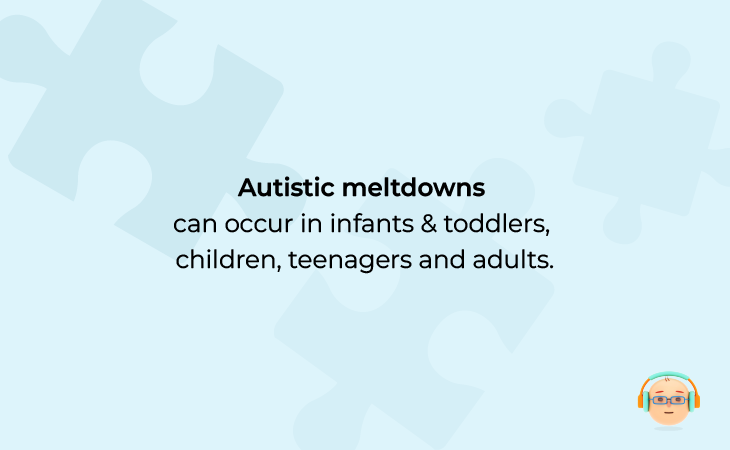
Download Download & share this knowledge card in your network [Free Download]
Preventing autism meltdowns
While it’s impossible to completely prevent every meltdown, there are numerous strategies that can help reduce their frequency and intensity for individuals on the autism spectrum.
-
Understanding Triggers
- Identify common triggers: This can involve observing the individual and keeping a journal of situations or events that lead to meltdowns. Common triggers include sensory overload, changes in routine, frustration, and social situations.
- Communicate effectively: Encourage the individual to express their needs and feelings, both verbally and non-verbally. This can help identify potential triggers before they escalate.
-
Creating a Supportive Environment
- Establish predictable routines: Provide structure and consistency in daily activities whenever possible. This can help individuals feel more in control and anticipate what’s coming next.
- Create a calm and predictable environment: Minimize distractions and overwhelming stimuli like loud noises, bright lights, or crowded spaces.
- Offer sensory tools: Provide fidget toys, noise-canceling headphones, or weighted blankets to help individuals self-regulate and manage sensory input.
-
Developing Coping Mechanisms
- Teach relaxation techniques: Deep breathing exercises, progressive muscle relaxation, and mindfulness can help individuals calm down during stressful situations.
- Social skills training: This can equip individuals with skills to navigate social interactions and communicate their needs effectively, reducing frustration and potential triggers.
- Visual aids and social stories: Using visual schedules, pictures, or stories can help individuals prepare for changes in routine and understand social situations, minimizing anxiety and potential meltdowns.
DON’Ts in Autism Meltdowns
During an autistic meltdown, it’s crucial to prioritize the individual’s safety and well-being by avoiding certain actions that can worsen the situation. Here are some key DON’Ts:
- Don’t try to force the meltdown to stop
- Don’t physically restrain the individual unless absolutely necessary
- Don’t yell, argue, or threaten
- Don’t shame or criticize the individual
- Don’t ignore their needs
- Don’t expect them to return to “normal” immediately
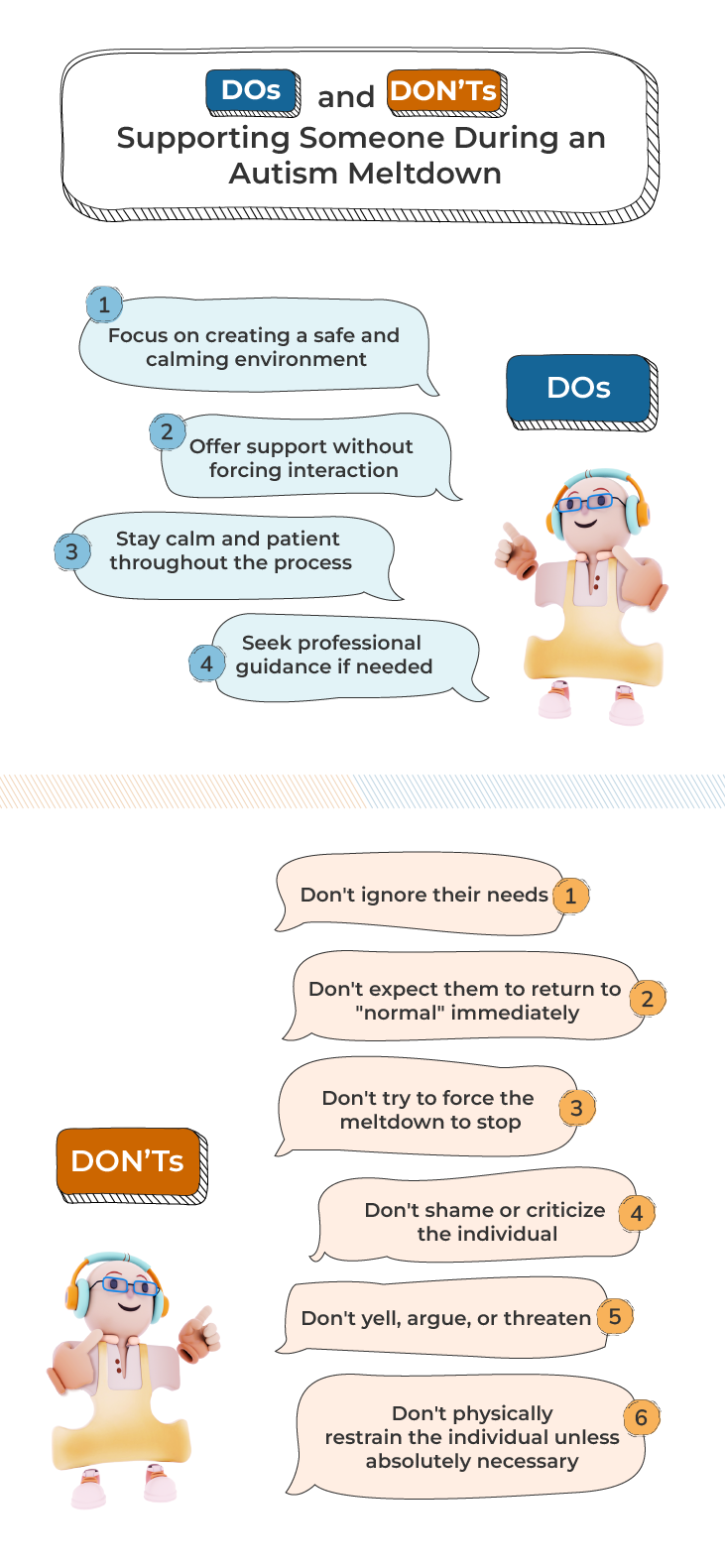
Download Download & share this infograph card in your network [Free Download]
Helping Hand: Tips for Responding to a Child's Meltdown in Public
If you see a child having a meltdown, they may be autistic. Here are some tips on how to help a child who might be experiencing a meltdown:
- Be respectful and avoid drawing unwanted attention.
- Remember, meltdowns are not intentional acts of defiance. Offer kindness and understanding.
- If you feel comfortable, politely offer assistance to the child’s caregiver or a responsible adult present.
- Respect the child’s personal space and create a calmer environment, if possible. This could involve dimming lights, lowering your voice, or offering a quiet area if appropriate.
- Remember, meltdowns can take time to resolve. Be patient and allow the child and their caregiver to manage the situation at their own pace.
Conclusion
This blog post has explored the complexities of meltdowns in individuals with Autism Spectrum Disorder (ASD). We’ve learned that meltdowns are not tantrums, but rather an intense response to feeling overwhelmed by sensory input, changes in routine, or strong emotions. Together, we can create a more inclusive and understanding world for everyone, including those who experience meltdowns.




